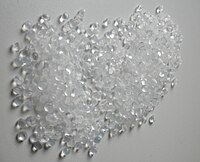
Photo from wikipedia
The mechanism of performance of hydrocarbon waxes used as external lubricants in typical PVC pipe formulations is not completely understood or defined. This study will benefit pipe manufacturers to tailor… Click to show full abstract
The mechanism of performance of hydrocarbon waxes used as external lubricants in typical PVC pipe formulations is not completely understood or defined. This study will benefit pipe manufacturers to tailor PVC processing conditions and wax addition levels to enhance the value of waxes with different molecular architectures in Sn-stabilized PVC formulations. A selection of waxes was comprehensively analyzed to understand how their structural and morphological differences impact the fusion behavior of a Sn-stabilized PVC compound. Results showed a high probability of fusion for waxes with melting points between 65 and 80 °C and a kinematic viscosity (at 135 °C) of less than 5 cSt across all experimental temperatures and concentration levels tested. The general probability of fusion increased with increasing temperature and decreasing wax concentration. Wax compositional differences only had a large impact on PVC fusion at lower experimental temperatures and high wax concentrations. The stable time and onset of degradation were found to be sensitive to experimental temperature but less so to wax concentration. High melting waxes had the lowest fusion torque but a narrow operating window in terms of concentration and temperature for a successful fusion to occur. Overall, fully refined paraffin waxes had the widest operating window and were less sensitive to a change in the wax concentration and experimental temperature than the rest of the waxes that were tested.
Journal Title: ACS Omega
Year Published: 2022
Link to full text (if available)
Share on Social Media: Sign Up to like & get
recommendations!